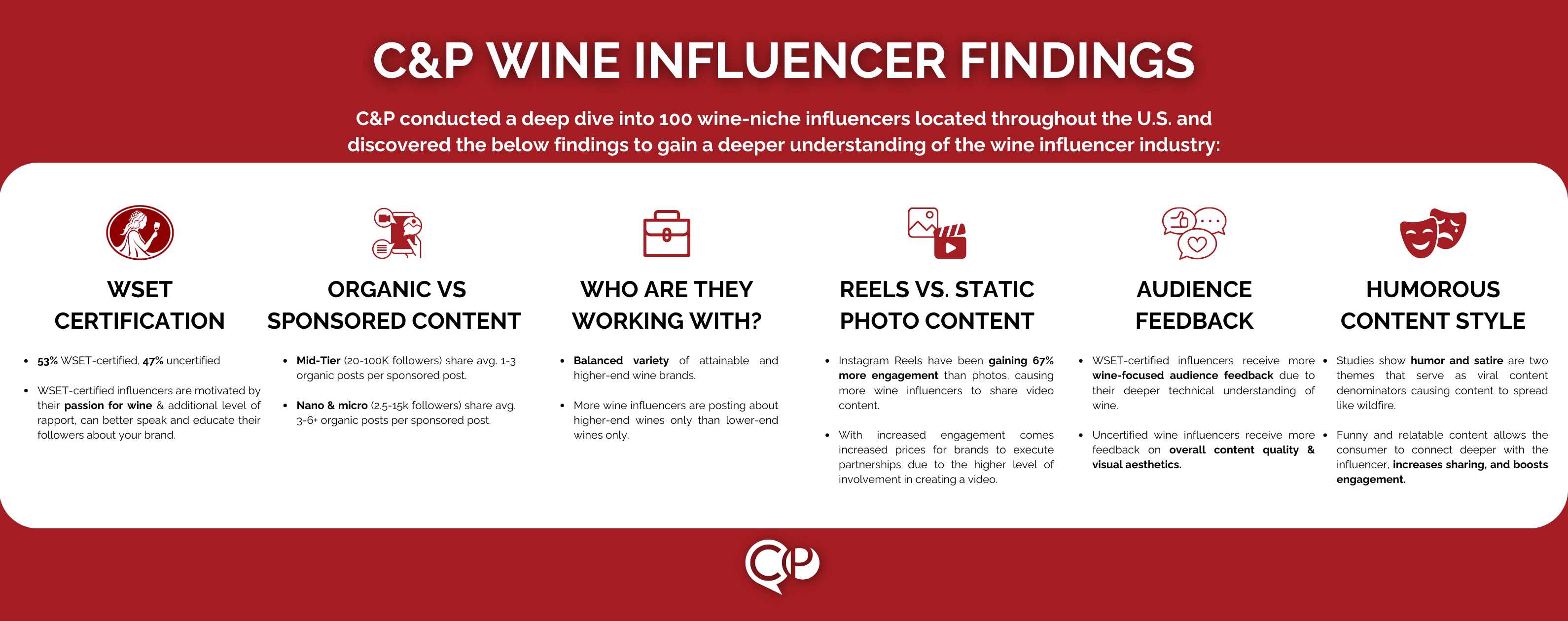Influencer marketing is a powerful tool that amplifies reach, fuels trust and builds an engaged community. According to a poll by Vinepair, a magazine with a readership of over 5 million, they found that 70% of readers listed friends as their most trusted source for wine recommendations. Wine influencers provide the closest replication of that ‘friend’ relationship in the digital space.
The Colangelo & Partners influencer team closely monitors all influencer activity, social media trends and audience feedback across all social media platforms in order to keep our clients ahead in the ever-changing digital landscape. By working with key wine influencers, we place our clients first in the minds of consumers and increase digital share of voice. The Colangelo & Partners influencer team conducted a deep dive into 100 wine influencers located throughout the U.S. We define a wine influencer as someone who shares exclusively wine and wine-related content on their social media platforms. Through our research, we discovered several key findings to gain a deeper understanding of the wine influencer industry and why you should be working with wine influencers.
WSET Certification
- Finding: Consumer-facing wine education and awareness is falling out of the hands of traditional industry experts and into the hands of passionate wine enthusiasts. The Wine and Spirits Trust (WSET) provides globally recognized education and qualifications to empower both professionals and enthusiasts. Through our research, we determined that 53% of wine influencers had some level of WSET certification while 47% have no WSET Certification.
- Application: These WSET-certified influencers are motivated by their passion for wine and additional level of rapport that allows them to better speak and educate their followers about your brand. As consumers spend increasingly more time on social media platforms, wine influencers can place your wines in front of a fresh demographic allowing the product to be more accessible and engaging.
- Finding: After reviewing wine influencers profiles for sponsored post activity, mid-tier wine influencers with followings of 20-100K, share 1-3 organic posts per each sponsored post, on average. Nano & micro wine influencers with followings of 2.5-15k, share 3-6+ organic posts per each sponsored post, on average.
- Application: The placement and delivery of an influencer’s sponsored post determines the success of the promotion. Ensuring that ads are placed in a way that seems organic to the influencer’s style is key, we work with influencers in a relatable way ensuring the content feels approachable to their audiences. At Colangelo & Partners, we analyze influencers for potential audience bots with influencer management tools, such as Tagger, and prioritize influencers with an engagement rate of 1% or higher (industry average). More specifically, wine influencers have an average engagement rate of 2.72%.
- Finding: Are wine influencers the right fit for your brand? Majority of wine influencers work with a balanced variety of more attainable as well as higher-end wine brands. More wine influencers are posting about higher-end wines only than lower-end wines only.
- Application: Gen Z consumers aged 21-24 are far less likely than older consumers to have a brand affinity to a certain wine brand providing wine brands an opportunity to educate and build a relationship with the next generation of wine drinkers through influencer partnerships.
- Finding: The wine influencers who have found the most engagement are those who have successfully broken down this complex industry into fun, accessible, short-form video and photo content.
- Application: The most widely used social media platform by wine influencers is Instagram, with over 120 million users. Compared to photo posts, Instagram Reels have been gaining 67% more engagement than photos causing more wine influencers to share video content. With increased engagement also comes an increase in prices for brands to execute these partnerships due to the higher level of involvement in creating a video.
- Finding: So what are these wine influencers’ followers saying? Wine influencers who are WSET-certified tend to have wine-focused audience feedback due to their deeper technical understanding of wine, for example, “This Pinot Noir paired perfectly with my Lamb the other night.” Non-WSET certified wine influencers receive more feedback on overall content quality & photo aesthetics, for example, “Your outfit matches the bottle.”
- Application: Depending on the campaign objective, influencers’ audience feedback can serve as a roadmap to deciphering which influencer to work with in order to reach your goal.
- Finding: After analyzing wine influencers’ top posts, we discovered there is a correlation between humorous, relatable content and high engagement. This content style evokes empathy and associates positive feelings with the post.
- Application: Implementing humor adds a ‘human’ element to social media content thus creating a deeper connection with the audience. Although a sense of humor can allow engagement with your current audience, it can also largely attract a new audience through increased sharing. Studies have shown that humor and satire are two emotions that serve as viral content denominators causing content to spread like wildfire.


